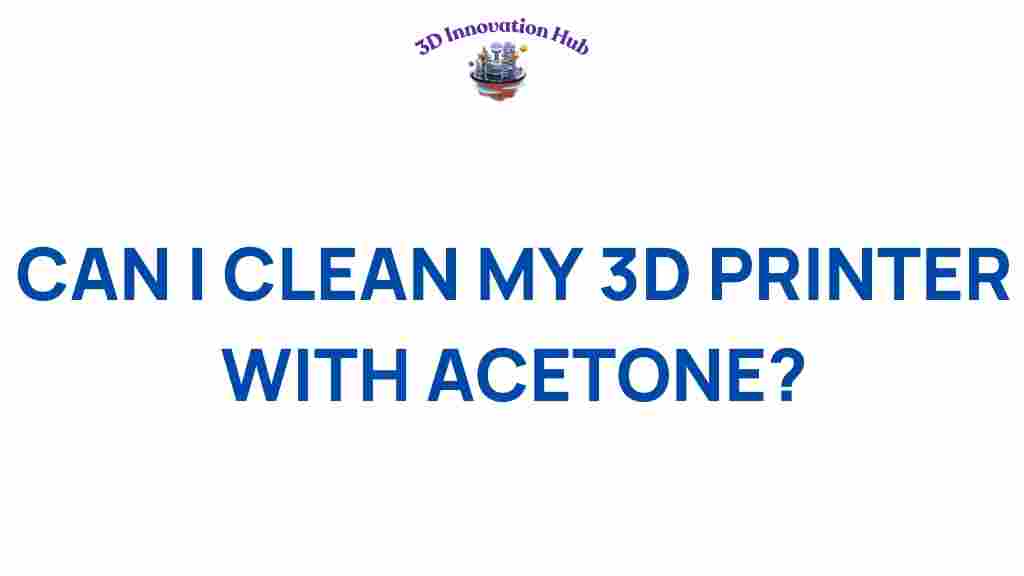The Surprising Truth: Can Acetone Safely Clean Your 3D Printer?
3D printers are remarkable machines that enable creators to bring their ideas to life with precision and ease. However, like any other piece of technology, they require regular maintenance to operate optimally. One common question among 3D printing enthusiasts is whether acetone can be used to clean their 3D printers effectively and safely. In this article, we will explore the use of acetone in cleaning 3D printers, the benefits and risks involved, and best practices for maintaining your machine.
Why Clean Your 3D Printer?
Regular cleaning of your 3D printer is essential for several reasons:
- Performance: Dust and filament residue can affect print quality.
- Longevity: Keeping your printer clean can extend its lifespan.
- Safety: A clean printer reduces the risk of fire hazards and other safety issues.
Using the right cleaning agents, like acetone, may enhance your cleaning routine. However, it’s crucial to understand how to use it safely and effectively.
Understanding Acetone
Acetone is a powerful solvent known for its ability to dissolve a wide range of substances, making it a popular choice for cleaning. It is commonly found in nail polish removers and is often used in various industrial applications. When it comes to 3D printing, acetone is particularly useful for cleaning up certain types of filament, especially ABS (Acrylonitrile Butadiene Styrene).
Using Acetone to Clean Your 3D Printer
Cleaning your 3D printer with acetone can be a straightforward process if you follow the right steps. Here’s a comprehensive guide on how to safely use acetone for cleaning your 3D printer.
Step-by-Step Process for Cleaning Your 3D Printer
Follow these steps to ensure a safe and effective cleaning process:
Materials Needed:
- Acetone
- Microfiber cloths
- Gloves
- Safety goggles
- Small brush (optional)
- Container for acetone
Cleaning Steps:
- Preparation: Start by turning off and unplugging your 3D printer. Allow it to cool down if it has been in use.
- Wear Safety Gear: Put on gloves and safety goggles to protect your skin and eyes from acetone splashes.
- Remove Filament: Take out any filament from the printer. This prevents any residue from mixing with the cleaning process.
- Wipe Down the Printer: Dampen a microfiber cloth with acetone and gently wipe down the exterior surfaces of the printer. Avoid soaking the cloth to prevent excess solvent from dripping.
- Clean Print Bed: For the print bed, if it’s made of materials compatible with acetone, you can use the acetone-dampened cloth to remove any residue. If you’re unsure, check the manufacturer’s recommendations.
- Brush Hard-to-Reach Areas: Use a small brush to reach tight spots, such as around the extruder and cooling fans. Dampen the brush with acetone if necessary.
- Let it Dry: Allow the printer to dry completely before plugging it back in or using it again. This typically takes around 30 minutes.
Tips and Best Practices for Using Acetone
Using acetone for cleaning your 3D printer can be effective, but it’s important to follow certain tips and best practices:
- Ventilation: Always clean in a well-ventilated area to avoid inhaling fumes.
- Test on Small Areas: If you are unsure about how a material will react to acetone, test it on a small, inconspicuous area first.
- Storage: Store acetone in a cool, dry place away from direct sunlight and heat sources.
- Regular Maintenance: Incorporate regular cleaning into your maintenance schedule to prevent heavy buildup.
Common Concerns and Safety Issues
While acetone is effective, it is important to be aware of potential safety issues:
- Flammability: Acetone is highly flammable. Keep it away from any heat sources or open flames.
- Toxicity: Inhaling acetone fumes can be harmful. Always ensure proper ventilation during cleaning.
- Material Compatibility: Not all 3D printer components are compatible with acetone. Avoid using it on sensitive plastics or electronic components.
Troubleshooting Common Cleaning Issues
Even with the best practices, you may encounter some common cleaning issues. Here are some troubleshooting tips:
Problem: Residue Remains After Cleaning
- Solution: Ensure that you are using enough acetone on your cloth and that you are applying enough pressure when wiping.
Problem: Damage to Print Surface
- Solution: If acetone causes damage, switch to a milder cleaning solution specifically designed for 3D printers.
Problem: Fumes Overwhelming
- Solution: If the fumes are too strong, take a break and allow the area to ventilate before continuing.
Conclusion
In conclusion, acetone can be a safe and effective cleaning agent for your 3D printer when used correctly. Regular cleaning and maintenance not only improve print quality but also ensure the longevity and safety of your machine. By following the tips and best practices outlined in this article, you can maintain your printer while minimizing risks. For more information on 3D printing maintenance, check out this comprehensive guide. For detailed safety guidelines, visit this resource.
Embrace the power of DIY cleaning techniques and keep your 3D printing experience smooth and enjoyable!
This article is in the category and created by 3D Innovation Hub Team

1 thought on “The Surprising Truth: Can Acetone Safely Clean Your 3D Printer?”